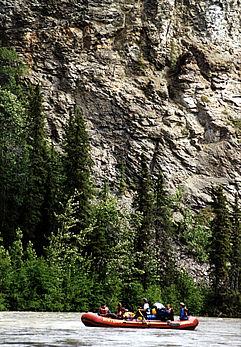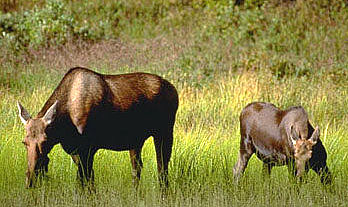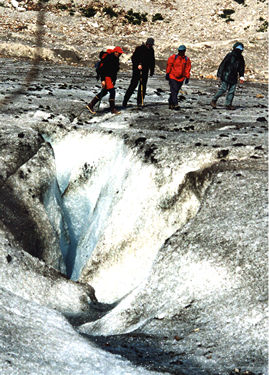

Out your back window, another nameless mountain. Darrell Hookey
Join Darrell Hookey, Yukon journalist and magazine editor,
on a river adventure never to be forgotten.

I parachuted from an airplane once. Of course, this has nothing to do with my 255-kilometer rafting trip of the Tatshenshini and Alsek Rivers, but I need a way to compare the feeling I had standing on the bank – decked out in rubber boots, rain suit, life jacket, sun screen and a sensible hat – watching the big water of this fabled northern river surge by at 16 kilometers an hour. From the sub-Arctic region of the Yukon Territory, through the highest mountain ranges of British Columbia, to Alaska’s Panhandle, I would soon be swept through some of the world’s most pristine wilderness to the Pacific Ocean.
Eleven of us were about to trust our lives to the Nahanni River Adventures rafts being expertly prepared by three river guides. These rafts had to stay together even if they were careening off canyon walls upside down, a prospect which did not seem altogether farfetched. Setting off from Shawshee or Dalton Post, Yukon, we faced an elevation drop of 615 meters [nearly 2,000 feet] riding three times the volume of water that flows through the Grand Canyon. Rafting is a lot like parachuting: they both go only one way.
Once you shove off you have no contact with the outside world. You are totally dependent on your training and the equipment you have. Well, for rafting that isn’t exactly true. We did have a satellite phone with us and a Global Positioning System. A helicopter could pluck us from a rock within 30 minutes of breaking a leg. And I consoled myself that we were in the care of some of very experienced river guides who were prepared to do everything but chew our food for us.
 The expression, go with the flow, takes on new meaning. Darrell Hookey
The expression, go with the flow, takes on new meaning. Darrell Hookey
No Turning Back
There is no sensation of moving when you are in a raft, nor when you are falling from an airplane. Just as I watched that airplane shoot skyward and away from me, I watched the bank drift away. The force of the Tatshenshini forbade that perch to the outside world just as determinedly as gravity prevented me from jumping back onto the plane. I wouldn’t see my world again until I landed – this time it would take 11 days, not just three minutes.
Right away we found out why they call this an “adventure tour”. Day 1 we were supposed to stop and camp along the banks after only two hours of rafting. However, our intended campsite was flooded by the more than expected Spring run-off from the St. Elias Mountains. “If it’s Tuesday, this must be Belgium” doesn’t work out here. Helmets were passed out as we were told we would be hurtling through Lower Canyon a day sooner than planned.
A more intense safety lecture than the pre-launch chat was presented. As amiable and goofy as our river guides could be, we gleaned from the lecture that these men had a tremendous respect for the power of “The Tat” and none of us would be hurt. They knew the river was in charge, and followed its rules. They also knew the Venturi Principle: a constricted flow of water will compress and/or speed up.
 Encounter black bears and grizzlies in valleys and along shorelines. Terry Parker
Encounter black bears and grizzlies in valleys and along shorelines. Terry Parker
As the canyon walls closed in, The Tat became furious at being constricted. It built up energy in waves leaving horrific voids to be crashed into just as the next wave threw our rafts into the air again. Outcroppings caused eddies; rocks on the river bed caused even more waves. A boulder protruding from the surface formed a dreaded “hole” as a waterfall was impossibly created heading upstream to fill the vacuum behind it.
About as Luxurious as It Gets
Soaking wet and numb from excitement, we landed at Silver Creek, helped unload the rafts, and then pitched our tents. Dry once more, we ambled to the kitchen area and were surprised yet again by our river guides. After battling the worst The Tat had to offer and bringing us to this safe harbor, they had already set up benches around a cheery fire.
Bob Hanley, the crusty but loveable lead river guide from Whitehorse, Yukon, savored the shocked look on his guests’ faces as he offered a tray of appetizers of smoked halibut, crackers and cheese. Behind him, Trent Abbott and Ron Morrison, both from Ontario, prepared a salmon with two different sauces and had already whipped up a tangy, yet sweet, salsa. For dessert (surprise, surprise) a delicate banana cream pie.
We were all confused. But surely, we told ourselves, this was the last time we would see fresh vegetables, fruit and meat on this trip. Every day the rafts’ coolers proved otherwise.
 The menu does not include beans and wieners. Terry Parker
The menu does not include beans and wieners. Terry Parker

Nature’s clothes line quickly dries clothes after riding the rapids. Darrell Hookey
Next morning I awoke under a carnival of color and shapes as my canvas ceiling glowed with the morning sun. I had slept soundly for 10 hours with The Tat still roaring outside my tent. It was a blessed substitute for my clock radio back home telling me my favorite sports team had lost again, and, by the way, it’s time to get up and go to work. I was still luxuriating in those first-day-of-vacation feelings when I heard “Coffee, hot water for tea, hot chocolate” wafting from the kitchen area where a fire already warmed early risers.
Much better than a clock radio. I still had to get my mind around the fact that for the next 10 days I won’t have my day start with an alarm, or I won’t have to fight traffic, or I won’t have a newspaper to read, or a radio to listen to, or even a CD player, or a video game. My leashes in life (cell phone, pager, emails) and chains (time, intentions, obligations, design) were all gone. I dressed in my own sweet time and headed out for fresh-brewed coffee, juice, a light and airy omelet and a chat with new friends.
The River is Nature’s Highway
On the water once again, I contemplated rafting as the perfect way to enjoy Nature at its wildest. Today lounging in a raft sweeping silently along smoothly enough to hold my camera still for pictures, we don’t scare away the wildlife, and there’s time for it all to sink in.
I think about this river almost lost to a copper mine development in the1980s. The toxic fallout would have threatened 50 mammal species that depend on this river. Roads and construction would displace grizzly bears, dall sheep, mountain goats and wolves. Tailing ponds and dams would be risky since the proposed site was in the most seismically active area in North America. As one of only three major salmon-bearing rivers on the northern Pacific coast, the bald eagle population would have been equally threatened by development.
Lobbyists for the mine argued that only a pampered few would ever see this river system. I looked at my fellow guests and saw a nurse, civil servant, teacher, small business owner and an administrator. None of them seem very pampered to me.
 Dwarfed by Nature in Quiet Canyon. Darrell Hookey
Dwarfed by Nature in Quiet Canyon. Darrell Hookey
One thousand such people experience this river each year, mostly as guests of river guiding companies. At the urging of Tatshenshini International (a coalition of over 50 conservation groups), the governments of British Columbia, the Yukon, Canada, Alaska, the United States, and the Champagne and Aishihik First Nations co-operated to create a Class A wilderness park. The St. Elias-Tatshenshini World Wilderness Reserve is now 8.5 million hectares of pristine nature that will never be developed. It is the largest reserve in the world. Delicate wild flowers blanketed the alpine tundra, yet we disturbed none of them. Our fires were built in fire pans to prevent scorching the ground, all of our waste was carried out and we even scattered rocks and un-used firewood to make it look like we had never been there.
You can’t experience everything from the raft. Camping beneath an unnamed mountain at Sediments Creek, some spent the day relaxing in camp, and the rest climbed the first hill. The fittest climbed the mountain behind. It was our first look at the sweeping vista we’d been floating through. The Alsek Mountain Range awaited us downriver, its meltwater spilling into the Tatshenshini, along with the O’Connor River, to double its size.
 Cow and calf moose. Terry Parker
Cow and calf moose. Terry Parker
Contemplating the Pace of Life
At our next camp, the mood became quiet. The excitement of new friendships gave way to the space we allow, and the serenity we take, from old friends. People found quiet places to sit and think, or take long walks along the shore or writing in journals. Years of hectic lifestyles were surrendered to the gentle nurturing of Nature. On a trip like this you are never hungry ….. but when food is offered, you eat. And you are never tired … but when you lie down, you sleep.
After a two-day stay, we floated down to Confluence, by far the most beautiful and serene spot on the river. This is where the Tatshenshini meets up with the larger Alsek River taking on the latter’s name. They meet in a bowl of surrounding mountains where a glacier once carved its route. From this spot we could see 27 different glaciers hanging over the shoulders of the mountains, barely containing the world’s largest non-polar ice cap.
In all, there were 31 surge-type glaciers and 350 valley glaciers. We got our up-close encounter with one at the next camp. It is called Walker Glacier, for the unusually simple reason it is close enough to walk on. Approaching it we were in T-shirts, but once we climbed over a small hill and stepped onto the glacier we hastily pulled out sweaters against the cold of the ice and jackets for the wicked valley wind.
The glacier had its own eco-system. Moss actually grew on the ice and willows had planted themselves in the dirt pushed out of its way. Although the pressurized ice doesn’t melt fast, there was a river beneath the glacier roaring towards the Alsek River. Ice crunched beneath our feet as we walked to the aqua-colored, craggy peaks of the mass retreating between the mountains.

A day of hiking at Walker Glacier. Darrell Hookey
Entering the Alaska Panhandle
Our final two nights were spent on Alsek Lake, where the other face of an ice cap was exposed to us. Icebergs, calved from glaciers, floated in a field of frozen statues. From shore we could count at least a hundred. It was the first time in nine days we hadn’t heard the rush of The Tat, but the eerie quiet was broken somewhere to the right of us as an iceberg flipped over in an explosion of splashes. The underwater currents melt the icebergs faster on the bottom than the sun from atop. It all happened so quickly, it was difficult to decide which one just flipped.
 Rafting among the icebergs. Nahanni River Adventures
Rafting among the icebergs. Nahanni River Adventures
Next day we took a tour of the icebergs in the rafts. We were careful not to get too close in case one flipped on top of us. Back at camp, we enjoyed our last night practising loon calls, pretending we didn’t have to return to our other world.
Just as my parachuting adventure began with an airplane, this adventure exploring one of the last refuges of Nature ended with an airplane. A Hawker Sidley turbo prop came thundering through the trees onto an impossibly short and narrow runway at Dry Bay, Alaska. The technology and civilization of this plane thundering into our consciousness was a little too much, a little too soon. As we settled into the cushioned seats and gave our snack orders to the flight attendant, we all fought off sleep long enough to say goodbye to The Tat.
Looking down from the plane, we were shocked to see the river, recently so huge and powerful, as a thin ribbon of life winding through seemingly endless snow-covered mountain ranges. It now seemed small and fragile. After 11 days, it had taught us that Nature and the human soul make perfect companions.
 The Alsek River at the end of a memorable day. Nahanni River Adventures
The Alsek River at the end of a memorable day. Nahanni River Adventures
FOLLOW UP FACTS
Based in Canada’s Yukon Territory, Nahanni River Adventures, www.nahanni.com, literally covers the northern region of the North American continent with “eco-river expeditions from Alaska to Nunavut”. Because of the area’s general inaccessibility, itineraries are usually two to three weeks long, using either traditional two-person canoes, 32-foot voyageur canoes or safe, stable expedition rafts. About 50% of guests are over 50 with 70% usually traveling solo. An impressive 40% is repeat business and 30% comes from client referrals.
The Tatshenshini River Expedition by Raft: view details.
Darrell Hookey is a freelance journalist and magazine editor living in Whitehorse, Yukon. He knows the Yukon and its people intimately, yet his writing reflects the amazement and wonder he still feels for his northern home. Darrell’s articles have appeared in such magazines as Reader’s Digest, Home Business Report, Maturity, and Up Here.
